“In his early years Mr Hobbs kept a diary, with the assistance of which he has recorded his recollections of three-quarters of a century. His memory is full of incidents – the coming of the railways, the hat trade of 50 years ago, and many other happenings which form the subject of this and future articles.” Luton News, May 18, 1933.
Migration of Lutonians to Yorkshire, 1860
Somewhere about this time a number of Luton people migrated to Keighley and Barnoldswick in Yorkshire on account of bad trade here and a brighter outlook there. A few years later I called to see them and for many years they or their children made annual pilgrimages to Luton.
On the LMSR 469 passengers were booked to Barnoldswick. Among them I remember the names of Worsley and Draper, and I believe the late Mrs Edwin Oakley had associations with that part of Yorkshire.
Influential Families
Among the local families of those days, the Wallers were perhaps the most influential. Their house was where Barclays Bank now stands and attached to it was a huge garden. I well remember this land being sold as building ground and the streets laid out.This garden comprised practically all the space between Guildford Street, Church Street, George Street and Barber’s Lane and Bute Street for about 100 yards. A long row of trees (willows I believe) overhung the Lea from Barber’s Lane to Church Street. Cheapside from George Street existed only as far as the site of the old post office. For a long time after, the land where now stands the theatre, Messrs Robinson’s and Messrs Walter Webb and Baker’s factories was strewn with logs.
For several years, we boys played upon the ground not occupied by the market.A mulberry tree stood about where the present fish section is.
The streets and the site of the garden were named after the family who had sold the ground. Cheapside retained the little cul-de-sac length near George Street,but was extended to John Street. This (John Street) was an elbow street from Bute Street to Church Street. Silver Street is a new title to the bend at Cheapside. Cheapside was not extended until the early 1880s when, for a while, it was known as New Cheapside – John Street to Guildford Street.
Dr Melson was a Birmingham physician and was renowned as a local preacher. He was a member of the Waller family, hence the name Melson Street.
Another great man was Mr John Everitt. His residence stood alone upon Hart Hill and in those days was little more than a cottage: two new wings were added later. A short cut to Hart Hill from Pondwicks was by a level crossing over the Great Northern Railway. This disappeared with the making of the Midland Railway.
My connection with Messrs Beecroft & Sons in 1878 led to a life’s friendship with Mr Edward Beecroft. He became associated with a big and successful firm of south coast drapers, a local preacher, a magistrate and a golfer and, although over 80, he still practices the three latter. It has been my pleasure, now ended, to have many a tussle with him at golf.
School Days
During my schooldays which, alas, terminated early, I had as masters Messrs John Thompson and Charles Powell. About 1875 I met Mr Thompson in Dundee and again about 15 years later. He was then rector of Roslin, Edinburgh. Mr Powell used to employ me to carry notes of a certain special character to Miss Brown and it did not surprise me when they got married. Mr Powell also took Holy Orders and became Vicar of East Coker, Somerset.
Walking along the street in Melbourne, Australia, one day in 1909, I recognised a form and the footstep before the pedestrian could pass me. I at once said ‘You are Mr John Cain’. We dined together and he then told me he was a Church of England missionary resident in India! He was one of my school teachers of about 45 years ago.
Scarborough’s Meadow that I knew for 20 years or more as a favourite place for school treats is now covered by the last streets lying between Dallow Road and Ashburnham Road. Beyond the infirmary it was all open country except for a cottage in a dell nearly opposite the infirmary. Schools taking part in combined efforts would meet upon Park Square and march to the meadow. In particular I remember the celebration of the Sunday school centenary about 1882 when there was a massed effort to sing before forming into procession. The singing was led by a cornet and conducted by Mr George Wing. Probably 10,000 persons were present in Park Square.
Four Significant Characters
In the 1860s four men made an indelible impression upon my young mind. They were Charley Squires, the postman who trudged along with a pile of letters three or four inches thick for delivery;
Tom Cook, the kindly old drayman who was an adept at shouldering heavy boxes for his lorry;
John Church, the chief of the Midland draymen; and last, but not least, that mysterious engine driver Johnny Moon.
It was said of Moon that he had driven the Queen [Victoria] and he could make his engine go “a mile a minute”. Johnny must have been envied and worshipped by many a boy.
Memories of Chapel
This is how a youth’s Sunday was spent in those days: school 9am-10.15am, chapel 10.30am-noon; school 2pm-3.30pm, prayer meeting (at some cottage) 5pm-5.45pm, chapel 6pm-7.50pm, prayer meeting 8pm-9pm.
I was one of those who laid a brick when the foundation stones of Waller Street Chapel were laid on May 18, 1863, and was present at the opening of the chapel. Davis, in his History Of Luton says it was opened on November 9, 1863 (or in less than 24 weeks!) and states: “The building will seat 900 persons,” but within six lines of type on the same page he writes: “It will seat 1,200 persons”. Before Waller Street Chapel was opened I attended Chapel Street, except for a short term while I was a chorister at the Parish Church. My boyish mind failed to understand how one could hear the preacher at such a great distance! I very well remember the shocking arrangement which then existed for emptying the throng that attended. It must have occupied ten minutes.
The Rev C.H. Spurgeon noticed this and subsequently kept his promise to preach again to raise the funds for extra exits at the back.
Miss Geraldine Harper was a much sought-after personality in those days. She created quite a sensation in Chapel Street Wesleyan Church by her trenchant speeches. Subsequently she visited Dunstable, Mayor Bailey taking part in the services.
Mr Nathaniel Smythe was another remarkable speaker. He held a temperance mission at the front of the Corn Exchange,but removed to the Moor to obtain more room for his audience.
Entertainment
Guildford Street was houseless from Barber’s Lane to Church Street for I remember about 1865 I ran a race there – and won. About this time a “show” was permitted on land where Mr Cox now has his jeweller’s shop and an amateur Blondin performed upon a tightrope. On the other side of the road there was a pond which in cold winters attracted sliders.
Luton must have been a very drab place to live in in those days for such excitement as a circus procession or a cavalcade would draw a large proportion of its inhabitants to watch, while a concert or a lecture were things to look forward to also as great events.
A roller skating craze gripped Luton and the rest of the country about 1876 or 1877. In the winter Luton sent its surveyor to Manchester to learn how to instruct in the making of a floor for the new sport. The baths were soon covered and Lutonians enjoyed a brief fling.
For 20 years or more, from the middle 1880s, the Luton Lantern Mission held an honoured and useful place in Luton’s history. I was soon invited to help by the four originators. Services were held upon the 25 darkest Sunday evenings of the year and so great and yet so simple were they that people were known to walk several miles to attend. The present mayor took a keen interest and, as one of the readers, his voice penetrated through the Waller Street market, then known as the Plait Hall. It is safe to say that during its brief 20 years of life it had more than half a million attendances.Like the coaches fading when trains came, so did these “dead” pictures fade and languish when the “animated” came, but if these latter could but be soaked with good gospel truths and teaching, a greater following might reasonable be expected.
Storms and Other Disasters
July 8, 1865, was remarkable for a terrific storm and flood which exceeded the capacity of the sewers. The flood gates near the river in Barber’s Lane were burst open and we boys were watching the newly created stream down the lane towards the (then) gardens and open river.
A piece of timber resembling a railway sleeper was thrust up from the sewer and found a lodgement against the traffic posts which, alas, had the effect of diverting the unwelcome stream into our gateway (I then lived where Messrs Currant Creak’s factory is now). The drainage was too poor to cope with this extra pressure and soon we saw the whole length – about 60ft – of wall fall into the flooded stream.
A year or so later (about 1871) an important fire destroyed the corn mill, then occupied by Mr Bates (later by Mr Locker). The Luton Water Company’s water was used upon this as its first big effort to lift several jets and was highly prized. The flames were so great and the heat so intense that one felt scorched to pass along Waller Street into Melson Street.
Hearing that the main line had been blocked in the storm, Mr Edmund Wiseman and I walked out to Chalton to see it. Just beyond the high bridge in the cutting hundreds of tons had slid on to the “down” rails and so pushed the “up” rails out of the straight that, in an effort to get some Pullman cars by, the buffers in one pair slipped by each other so that they became locked. It was deemed so risky that the train simply crawled to Luton, where the faulty pair were taken off to await a divorce. This was long before the good tracks were added.
Another terrific deluge, which resulted in a landslip on the Midland line, occurred about 1879.
We ventured to prophesy that Luton would also suffer from the flood we saw at Leagrave, and so it did; the Lea soon overflowed in New Bedford Road and flooded much of Manchester Street.
The winter of 1880-81 brought a terrific snowstorm. On January 18 the railway line just beyond Dunstable Town Station was blocked. Three trains became embedded in a four or five foot drift.
About 1880 the keeper of the Luton General Cemetery visited Bury, Lancashire, to see his daughter. Upon his return he labelled his luggage “- passenger to Luton Cemetery.” In his excitement to alight he got between the platform and the train and was killed.
Photography
Before the days of half-tome blocks I used to publish real photographs of the newly appointed mayor and of Mr Cyril Flower, our local MP (later Lord Battersea). Through this latter gentleman’s kindly aid we arranged, in 1886, for a photograph of Mr W.E. Gladstone at Hawarden Castle.
Mr companions were Mr Peter Wootton (president of the Luton Liberal Association) and Mr Frederic Thurston as photographer. When Mr Gladstone sat for his photograph (his chair was most unsuitable for a pose), Mr Thurston bade him sit up a bit! This the GOM did, but when Mr Thurston saw his image upon his focusing screen, he said, “Sit up a bit more, sir, please”. Gladstone did not hear him, so I uttered the word again, and so between us we got the great veteran to sit up!
Transport
I think it was about 1870 or 1871 when I learnt to ride a boneshaker. This was chiefly done upon the quarter-mile stretch at the top of London Road hill and it was probably about 1872 I rode a race; a youth on foot with 100 yards start and I upon a “penny-farthing” with thick iron spokes and iron tyres about an inch wide. The race was from the first to the second mileposts and he beat me by about six yards.
About 1878 I rode a somewhat improved penny-farthing from Luton to Leighton Buzzard in 72 minutes. In 1910 I did the same journey by cycle in 55 minutes. In the penny-farthing days brakes were not fitted to every machine, experts deemed them infra dig, but to descend even our London Road hill without one ran very near disaster.
I believe I was the first owner of a “safety” in Luton, as the present form was first called. This was probably in 1886. Until the advent of the cycle – which, by the way, was soon capable of outrunning a horse – the usual form of road transit for me was on foot. The cycle increased my possible radius enormously so that a much larger district became open to me. And now buses have knit the whole country closer.
For picnic parties Ashridge used to attract many. In these days of quick transport it seemed incredible that Luton pleasure seekers could spend three hours each way upon the journey of about 14 miles, but that was the rule.
Sixty years ago, or thereabouts, a Colonel Stewart made a hobby of running a stage coach between Luton and St Albans and (I think) to London. My friend Henry Smith (afterwards superintendent of Park Street School) and I paid 2s each for the trip to St Albans and walked home.
A Channel adventure fell to my lot in 1875. A party of us boarded the Moss Rose yacht at Ramsgate to sail to Calais. We saw its spires but the wind chopped around and drove us towards Dunkirque; at Gravelines, however, we essayed to make for the harbour, but, taking the wrong side of the pier, were wrecked. In small boat loads we reached the slippery pier and so to the village. We had to await a suitable tide and arrived at Ramsgate 20 hours after starting.
Pubs and Licensing
When in 1873 the Luton magistrates, headed by the Rev Hugh Smith, their chairman, determined to restrict licences for the sale of intoxicants, it was quoted as a new “system” or “experiment” about the country and I was not a little proud to be asked about it in Liverpool. They have recently refused a licence there for a colony the corporation have built up. I had the privilege of congratulating them upon it three years ago in the Liverpool Daily Post.
In the early 1870s, with a population of only 17,000, thirsty souls were invited to quench their thirst at six public houses within a stone’s throw of Wotton & Webb’s, in addition to those now standing! An itinerant fishseller who rather often imbibed was heard to say: “If both the banks of Luton fail and the Bank of England crash, bring your notes to Neddy’s gates, there you shall have your cash!”
Family Matters
I married in 1876 and my wife and I went to live in Manchester for 18 months as the best centre of the ground I covered as a commercial traveller. I attended many meetings at the Free Trade Hall and heard Sit Wilfred Lawson and Mr John Bright there. Incidentally, I was assured that the grey-haired gentleman who took down speeches or sermons was Sir Isaac Pitman.
While we were at Manchester my wife made dolls’ hats in such a manner and so up to date as to command a ready sale in some of the high class shops. Incidentally, this was a great help to our scanty income.
Lighting Up Time
The days have long passed when men were employed to go round with a dwarf ladder to light the lamps by striking a match at each. It took many years to discover that a hook upon the end of a little pole with a tiny lighted lamp inside would immediately do the trick. Now, in England and in other countries, a bypass tube and regulated clock manage the lighting up and the turning out at the time arranged.
Cheapside Post Office
On the occasion of the public opening of the Cheapside post office on September 29, 1881, I stepped from my platform seat as soon as the office was declared open and, anxious to buy the first stamps sold there, I bought a pane (120) 1d stamps. They by chance happened to be of the brief nine-dot issue. I subsequently sold them for six and a half guineas.
The Band of Hope
Other demonstrations on a big scale used to be carried out there by united Bands of Hope. In 1882 it seemed desirable to abandon the Sunday delivery of letters so that postmen could get their day of rest as London had. An army of willing workers canvassed the town for signatures and were successful in obtaining a large number favourable, but alas about 45, including one large firm signed a counter memorial (one eccentric signing both) and matters proceeded as before. When the war came the delivery was dropped and I have never had anyone express a desire for its recurrence.
The Salvation Army
When about 1883 the Salvation Army, then in its infancy, met with serious opposition in Luton, several of us were sworn in as special constables and had to march around the town to support the Army adherents. My father marched, too, to protect me! Shortly after, a lad in a red jersey used to speak for the Army in front of the Corn Exchange. This same speaker is one of Luton’s foremost public speakers today.
Soon after the coming of the Salvation Army a man styled Captain Harris was put in command. He created little short of a general sensation. Upon one occasion he promised a fatted calf for a great supper, then, by and by, he stated he couldn’t have a fatted calf – it wouldn’t be be big enough, so he had a bullock roasted. When he left Luton he had an unprecedented throng to see him off. The bridge in Station Road and even Midland Road were crowded.
Another remarkable officer was Lieut Charteris. She accompanied a few temperance speakers to a neighbouring village and, finding there was no audience, she marched her handful of conglomerate soldiers from a pond, through the village, and soon the meeting place was besieged.
Miscellaneous
My diary about this time records that on June 6, 1868, I bought a pair of shoes at Mares’ for 8s 6d, and three days later that I toured Hart Hill !
About this time I walked to Barton Springs for a day’s holiday. The beauty impressed me. Two or three years later a party of us took the train to Dunstable L&NW [North station] and walked to Totternhoe Knoll. I found further beauty there.
June 21 of that year was the hottest ever known in England – 101degrees in the shade and 126 degrees in the sun.
December 16, 1869: Putting up Corn Exchange clock (this, by the way, had a set of faces all metal!)
It is just about 60 years, too, since Mr Samuel Toyer was planting the trees which run at the back of Brook Street, upon the Moor. He did this while I was busy with athletics close by.
It was probably in 1870 that Park Town was added as a new district to Luton. It was first called “Brown Brick”.
Another thing that sticks in my mind is that about this time a Bute Street painter was contracted to number all the houses in the town. The Corn Exchange was the axle and odd numbers had to be on his left and even numbers on his right therefrom.
The Prince of Wales paid a visit to Luton in December 1878 and at Vyse Sons & Co’s factory inspected a device in reels of cotton spelling the word “Peace” which contained 823 miles of cotton.
The common pronunciation among the villagers then was “Lig-ruf””

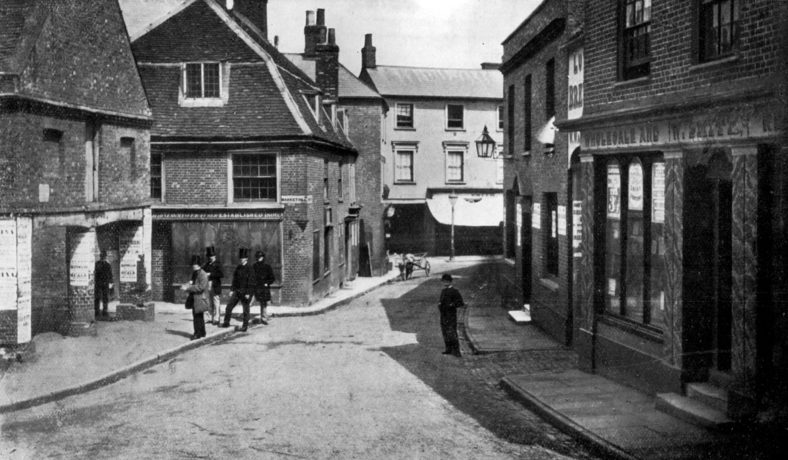
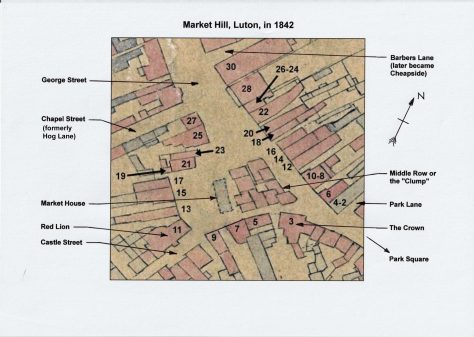
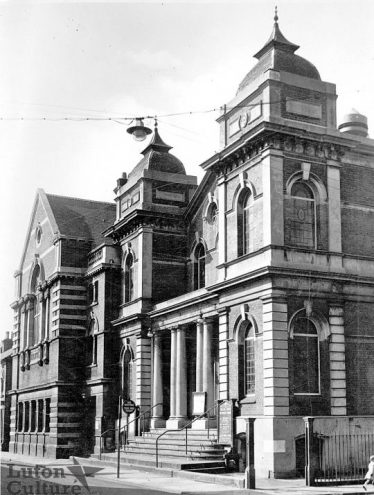
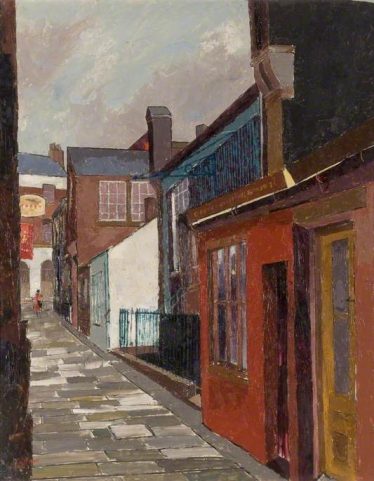
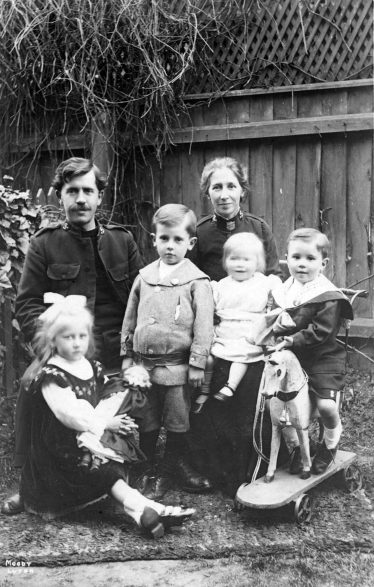






No Comments
Add a comment about this page